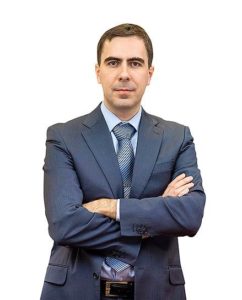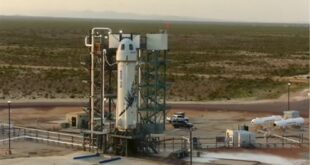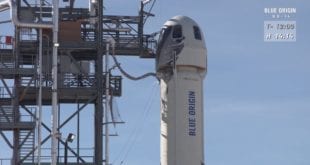
CosmoCourse is a private Russian space company which develops its own reusable suborbital space complex for tourist spaceflight.
SpaceWatch.Global Contributor Evgeniy Ryzhkov met with the company’s CEO Pavel Pushkin to talk about the suborbital space system currently under development, about competition within the emerging space tourism industry as well as the challenges and opportunities of doing space business in Russia.
Why is CosmoCourse aimed at creating a tourist suborbital system? Do you build your rocket from scratch?
When I worked at the Khrunichev State Research and Production Space Center, I was involved in the development of promising new rockets, including Angara. Our goal was to create a new competitive launch vehicle that would enter the launch market. At that time, SpaceX was just entering the market. Russian specialists had an opportunity to convince their authorities to start work on a new innovative rocket, get funding from the government and initiate the development. That said, we weren’t sure the rocket would be good enough. But after preliminary analysis it turned out that there were no tasks for the new rockets and nobody was interested in them. Now Russia is trying to develop the Soyuz-5 launch vehicle, but its prospects are vague because it is being developed for the state needs, so its future as a commercial launch vehicle is uncertain.
As a result, we had this idea to look at emerging markets, one of them being the nascent suborbital tourism market. Virgin Galactic was also actively trying to enter the market at that time. They sold a lot of tickets and initiated hardware testing. And we thought: ‘Could we create something similar that would be in demand?’. The answer was ‘yes’.
The market of launch vehicles for launching satellites is a pretty small one, all participants are dependent on each other. To sell a rocket launch you need customer demand, and customers are few and far between and mostly place orders with countries that produce launch vehicles. Sanctions must also be taken into account, meaning this is a very dependent market. Today we can see the problems that the Khrunichev State Research and Production Space Center has to face: there are few military contracts and no commercial orders. This has been caused by SpaceX and other competitors being active on the market.
The suborbital tourism market is different. We sell tickets not to companies, but financially independent individuals. They wish to have fun, they wish to fly in space, and so they are prepared to buy the tickets. So, we decided to work in this direction. Then an investor turned up, who wished to launch rockets, and we agreed with him that we would develop suborbital tourism. If we succeed in carving out a niche in this market, it is more likely to stay and move forward.
We do everything from scratch because the launch vehicle for suborbital flights must be completely reusable, and some safety requirements are also added. There has never been such a combination yet. The industry can show record-breaking characteristics for many systems, but we just need safe, reliable and cheap reusable systems.
Unfortunately, cooperation with someone else cannot help us to do it even if we pay our own money.
You are working on creating a reusable launch vehicle. What economic future do you see for reusable systems in comparison with disposable ones? Will both types of launch vehicles co-exist in the space industry in the 21st century?
We are creating a reusable suborbital rocket, which, by our estimates, can be launched 110-120 times per year. The reusability is both necessary and justified with such a heavy workload. After 10-12 launches of the same rocket item, we will write it off. We need to produce about 10 launch vehicles per year, which is feasible. In this case, the enterprise which produces the rockets will run on the break-even principle.
If we are talking about classical launches into orbit, there are only 10-12 starts per year. SpaceX does somewhat better with about 20 launches as it has contracts from both the US Department of Defense and commercial customers. Imagine that we have developed a rocket for the classical market and we write it off after 10 launches. Hence, 1 or 2 launch vehicles will need to be manufactured annually. And if you can make 50 launches possible for a reusable rocket, this will affect the people working at the enterprise: they have manufactured a rocket, and then we give them a two year vacation? This situation is hard to even imagine.
That’s why the future of rocket reusability is uncertain on the classical market. However, a combination of reusability and disposability can work. This is what Elon Musk does: he launches disposable rockets, and in some launches he reuses the first stage, but not more than twice. It works. But we must realise that Musk’s rockets are partially reusable: the first stage is reusable, but the second stage and the fairing are disposable (although there have been attempts to recover the fairing).
Again, Musk claims that it is possible to create a completely reusable launch vehicle – the Big Falcon Rocket (BFR) – a very large rocket, which allows to launch pretty heavy payloads into orbit. The BFR may have a future, but it will be difficult to enter the market with this rocket.
Suborbital flights do not require very high speeds and there’s no need for a second stage, so the capsule and the rocket take off and land at the same speed. It is easier to slow down when returning to Earth, there is no need for thermal insulation, it is possible to launch more frequently, etc. Thus, it’s much easier to create a fully reusable suborbital rocket, and it may find its best opportunities in this segment of the market.
How is Roscosmos involved in your project? Do you have a public-private partnership?
Roscosmos has two roles. The first is that of a governmental agency. It includes certification, regulatory support, licensing, legal and policy framework… The State Corporation performs its functions in this case: we have a license from Roscosmos, we work on documents that regulate the process of manufacturing the rocket, we will be certified and tested by Roscosmos.
The second function of Roscosmos is manufacturing. Here everything is more complicated. We wanted to cooperate with Roscosmos’s enterprises in terms of development, but in the end, we will work only with a couple of enterprises. All the rest we have to do ourselves because the main task of the enterprises is to carry out the Russian Federal Space Program and the State Armaments Program, both of which keep them very busy. We are a secondary task for them.
We wanted to pay money to the enterprises and get development and mass production in return. They answered to this proposal that they might be able to provide specialists for design work and organize manufacturing, but not for long. And if there is an urgent need to do something for the Russian Federal Space Program, they will take their specialists away. In the case of mass production, they can create a separate production line for us and assign some personnel to it.
And then we began to understand that we could do everything ourselves, without involving the Roscosmos enterprises. And it makes sense. And if some people came to me and proposed to develop an orbital rocket together, I would do the same – I would honestly explain that we’re fully dedicated to the suborbital project and there are no extra people and time. Therefore, I have no complaints about the industry enterprises.
This is why there is no partnership agreement between Roscosmos and our company. I understand Roscosmos’s position perfectly. They have a lot of their own projects that need to be developed and implemented. And here we come with our project and try to put additional workload on them. If we came to them and told them we needed, say, one of their innovative engines, we would probably come to some sort of agreement. So we are slowly getting used to each other and are trying to create a working bond.
Do you have any testing facilities of your own or do you plan to seek assistance elsewhere?
We are ready to bring people in from the outside, but for now, we are focusing mainly on our own capabilities. For example, we had, an interesting conversation at one of the enterprises regarding the use of a test facility. At first, we were convinced that there was a facility that fit our project in terms of its size and that it would be available in a couple of years when we got to the final test firings. Later it turned out that the facility might not be available, moreover, it would be necessary to remake it for us or even build a new one, using the related experience of that enterprise. In addition, the cost, most likely, would include returning the facility back to its original condition for the purposes of the Russian Federal Space Program. It is not some kind of fraud, it is a real situation that we have faced. And if someone told us that there was a facility that required minimal costs for modernization and was ready to be given to us, we would be happy to negotiate. And it turns out that it’s easier and more failsafe to do everything ourselves.
About the interviewer: Evgeniy Ryzhkov has been researching the Japanese space industry in Japan for two years and worked as a technical translator from Japanese in the industry. Currently, he is the corresponding editor of the Novosti Kosmonavtiki magazine.
Don’t miss the second part of this conversation on Wednesday.
 SpaceWatch.Global An independent perspective on space
SpaceWatch.Global An independent perspective on space




